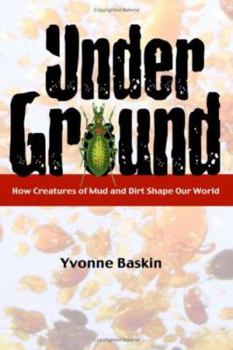Under Ground: How Creatures of Mud and Dirt Shape Our World
Select Format
Select Condition 
Book Overview
Beneath us lies what Science magazine recently called the true 'final frontier.' A growing array of scientists is exploring life in soils and sediments, uncovering a living world literally alien to... This description may be from another edition of this product.
Format:Hardcover
Language:English
ISBN:1597260037
ISBN13:9781597260039
Release Date:June 2005
Publisher:Island Press
Length:248 Pages
Weight:1.15 lbs.
Dimensions:0.9" x 6.0" x 9.0"
Customer Reviews
2 ratings
Her first-person exploration reveals a teaming, vivid world underfoot
Published by Thriftbooks.com User , 18 years ago
Under Ground: How Creatures Of Mud And Dirt Shape Our World focuses on soil and the creatures which evolve from there to shape our lives: from worms in a Minnesota forest which are making the soil too rich for wildflowers to mud-dwelling animals on the ocean floor, and soil microbes affecting both wilderness areas and gardens. Her first-person exploration reveals a teaming, vivid world underfoot.
Excellent guide through the underground
Published by Thriftbooks.com User , 19 years ago
In the unknown world under our feet uncatologued millions teem. Two-thirds of the world's biodiversity, according to Baskin (and her footnoted sources) lives underground, "the most diverse and abundant web of life known in the universe." Baskin introduces us to a few of these creatures - nematodes earthworms, slime molds, fungi, water bears - and takes us to frozen tundra, wetlands, forests and seabeds where they live. And she introduces us to the people who study them. People like the Wormherders of Antarctica who study nematodes (tiny worms), the most abundant animal on the planet. They study them in Antarctica because it's the one place in the world where if you change something in the soil, or remove one species, you can see the effect. Antarctica is the only place on earth where you can pick up a handful of soil and possibly not find nematodes. Cindy Hale studies earthworms in the forests of Minnesota - a place where there aren't supposed to be any earthworms. Marine biologist Melanie Austen measures nutrient recycling on the ocean floor and the effect of fishing draggers on the tiny living recyclers. And Renata Outerbridge and Tony Trofymow show how selective tree cutting can help the loggers as well as the forest. The creatures themselves are fascinating, not least because of the intricacy and complexity of their interaction with their crowded environment. Like the symbiotic relationship of fungi and tree roots, which involves antibiotics and decay as well as nutrient sharing, and without which, in a sever clear-cut, for instance, trees can never thrive. These creatures are also stranger than anything we see above ground. Nematodes have a gene structure which seems to fit them for survival anywhere on earth and when conditions are inhospitable they dry themselves out and go dormant, for decades if need be. No one has yet determined the upper level of a nematode's ability to revive from a dehydrated state. Earthworms, hermaphrodites the world over (many capable of self-fertilizing), are not always the "beneficial" creatures we think them. It wasn't until 1995 that scientists discovered earthworms are not native to forests and don't belong there. There are no native worms in the upper US and exotics, long beloved of gardeners, are disrupting the "thrifty" nutrient recycling of forests. Baskin ("A Plague of Rats and Rubbervines: The Growing Threat of Species Invasions") accompanies each of these scientists (and more) on their rounds, showing us their work and enthusiasm as well as explaining the ecology involved as human acts start unseen chain reactions. Her writing is fair and balanced, pointing out the unknown and documenting her research with copious notes at the end of the book. Accessible and enjoyable, this is a book for ecologists and anyone curious about the world we walk on.





